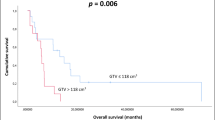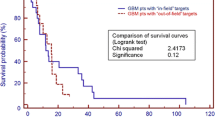Purpose:
To assess the effect of reirradiation in recurrent WHO grade III astrocytomas.
Patients and Methods:
From January 1995 to July 2003, 40 patients with grade III gliomas were treated with fractionated stereotactic reirradiation at the time point of recurrence. Median size of planning target volume for reirradiation was 56.2 ml (range 25.1–296.2 ml). A median target total dose of 36 Gy (range 20–57.6 Gy) was applied using a median fractionation of 5 × 2 Gy/week with a 6–MeV linear accelerator.
Results:
Radiotherapy was well tolerated by all patients. No toxicities > CTC grade 2 developed. Median overall survival calculated from the time point of primary diagnosis was 48 months (range 7–180 months). The 5– and 10–year overall survival rates were 49.5% and 24.7%, respectively. From the time point of reirradiation, median survival was 16 months (range 1–98 months). Median progression–free survival from the time point of reirradiation was 8 months (range 1–72 months). No prognosticators for survival or progression–free survival after reirradiation could be identified.
Conclusion:
Fractionated stereotactic radiotherapy is well tolerated and effective in patients with recurrent grade III astrocytomas.
Ziel:
Evaluation des Effekts einer Rebestrahlung bei Patienten mit WHO–Grad–III–Astrozytomen.
Patienten und Methodik:
Von Januar 1995 bis Juli 2003 wurden 40 Patienten mit WHO–Grad–III–Gliomen zum Zeitpunkt der Tumorprogression mit stereotaktischer fraktionierter Rebestrahlung behandelt. Das mediane Planungszielvolumen für die Rebestrahlung betrug 56,2 ml (Spannbreite 25,1–296,2 ml). Appliziert wurde eine mediane Dosis von 36 Gy (Spannbreite 20–57,6 Gy) auf das Zielvolumen in einer medianen Fraktionierung von 5 × 2 Gy/Woche mit einem 6–MeV–Linearbeschleuniger.
Ergebnisse:
Die Therapie wurde von allen Patienten gut vertragen. Es konnten keine Nebenwirkungen > CTC Grad 2 beobachtet werden. Das mediane Gesamtüberleben, berechnet vom Zeitpunkt der Erstdiagnose, betrug 48 Monate (Spannbreite 7–180 Monate). Die 5– und 10–Jahres–Überlebensraten lagen bei 49,5% und 24,7%. Berechnet vom Zeitpunkt des Beginns der Rebestrahlung, betrug das mediane Überleben 16 Monate (Spannbreite 1–98 Monate). Das mediane progressionsfreie Überleben ab Beginn der Rebestrahlung lag bei 8 Monaten (Spannbreite 1–72 Monate). Es konnten keine signifikanten Einflussfaktoren auf Überleben und progressionsfreies Überleben nach Rebestrahlung identifiziert werden.
Schlussfolgerung:
Die fraktionierte stereotaktische Radiotherapie wird von den Patienten sehr gut toleriert und ist eine effektive Therapieform für Patienten mit rezidivierten WHO–Grad–III–Gliomen nach Vorbestrahlung.
Similar content being viewed by others
Author information
Authors and Affiliations
Corresponding author
Rights and permissions
About this article
Cite this article
Combs, S.E., Gutwein, S., Thilmann, C. et al. Reirradiation of Recurrent WHO Grade III Astrocytomas Using Fractionated Stereotactic Radiotherapy (FSRT). Strahlenther Onkol 181, 768–773 (2005). https://doi.org/10.1007/s00066-005-1415-6
Received:
Accepted:
Issue Date:
DOI: https://doi.org/10.1007/s00066-005-1415-6




